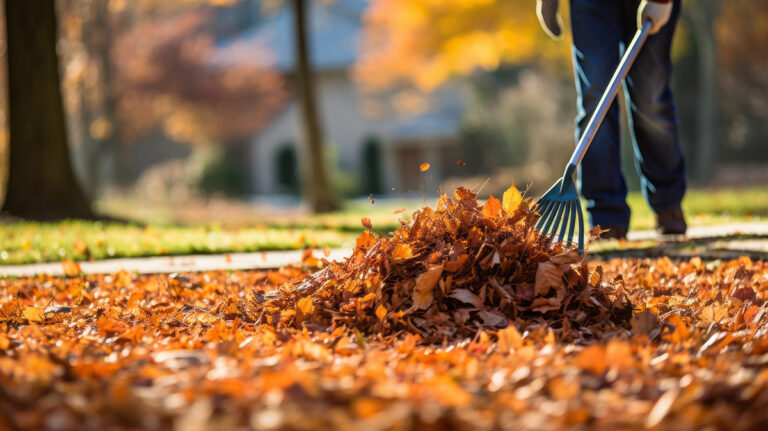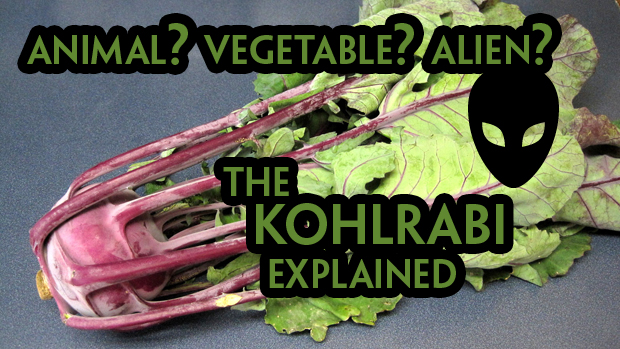
Yokel Food: Locally Grown Recipes and Wisdom from Yokna Bottoms Farm
by Betsy Chapman
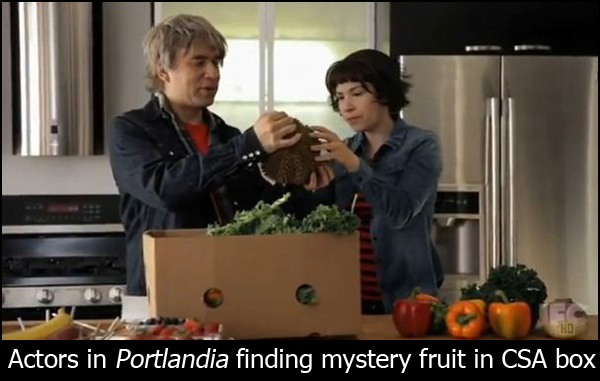 Last week, I watched an episode of the satirical, absurdist comedy Portlandia in which a hip, overly excited couple receives their weekly CSA box only to find a baffling, unusual exotic fruit that they have no idea what to do with. And so, of course, it sits on their counter—for days.
Last week, I watched an episode of the satirical, absurdist comedy Portlandia in which a hip, overly excited couple receives their weekly CSA box only to find a baffling, unusual exotic fruit that they have no idea what to do with. And so, of course, it sits on their counter—for days.
In an unexpected twist, the strange fruit begins re-organizing bookshelves and cleaning windows while the unsuspecting couple sleeps. Turns out the fruit is actually a space alien. As the fruit alien ascends into outer space, the couple watches on, waving and eagerly anticipating their next CSA distribution.
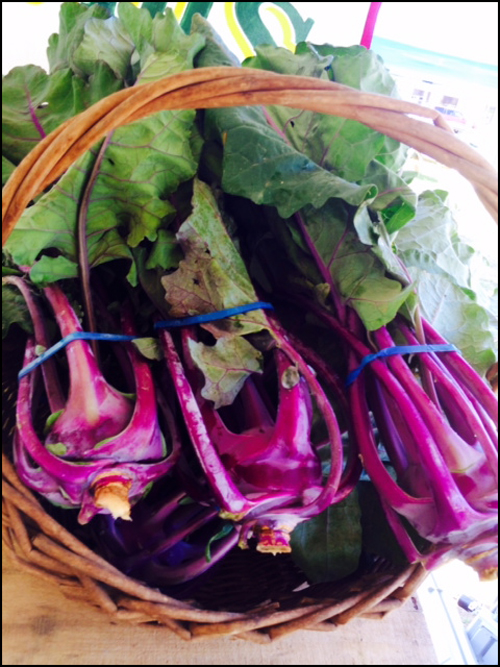 As a fan of absurdist comedy and a farm worker, this episode hit really close to home. I was reminded instantly of perhaps the most perplexing vegetable we offer at our CSA distributions and weekly farmers markets—the humble but totally confusing kohlrabi.
As a fan of absurdist comedy and a farm worker, this episode hit really close to home. I was reminded instantly of perhaps the most perplexing vegetable we offer at our CSA distributions and weekly farmers markets—the humble but totally confusing kohlrabi.
In appearance, the kohlrabi is often described as resembling a purple spaceship, a weird deep sea creature, or a green baby alien. I’ve seen even the most savvy market-goer rendered speechless when encountering this strange member of the Brassica family, traditionally used in German and Indian cuisines.
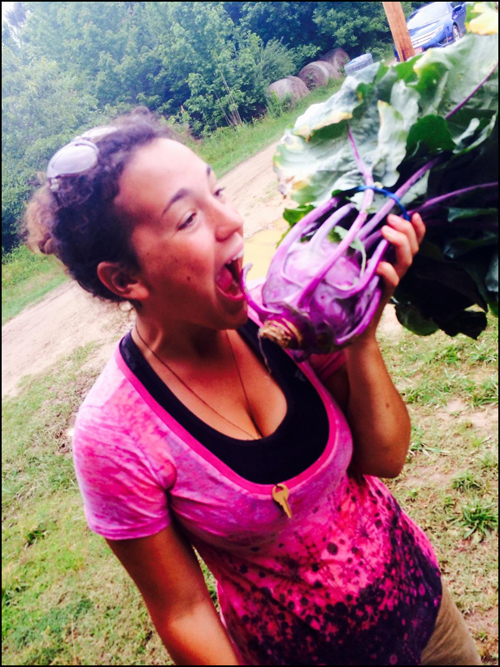 However bizarre it might appear, the kohlrabi is hardly exotic, very versatile, and quite tasty. The kohlrabi is an AKA kind of vegetable—sometimes called a German turnip, turnip cabbage, or above-ground turnip, this cabbage cousin has a softball-sized green or purple bulbous base topped with long slender stems and frilly greens.
However bizarre it might appear, the kohlrabi is hardly exotic, very versatile, and quite tasty. The kohlrabi is an AKA kind of vegetable—sometimes called a German turnip, turnip cabbage, or above-ground turnip, this cabbage cousin has a softball-sized green or purple bulbous base topped with long slender stems and frilly greens.
Pronunciation: “Cole-Robby”
Taste: Mild, sweet, crisp flesh. A little like broccoli with a dash of turnip and splash of cabbage.
Preparation: All parts of the kohlrabi are good for eating. The round base must be peeled before eating or using in recipes.
Raw: Kohlrabi is a cool, crisp raw snack, thinly sliced, sprinkled with salt, pepper, and olive oil. Sliced into sticks, kohlrabi makes an excellent and unusual addition to a veggie tray. The bulb can also be grated and used in coleslaw.
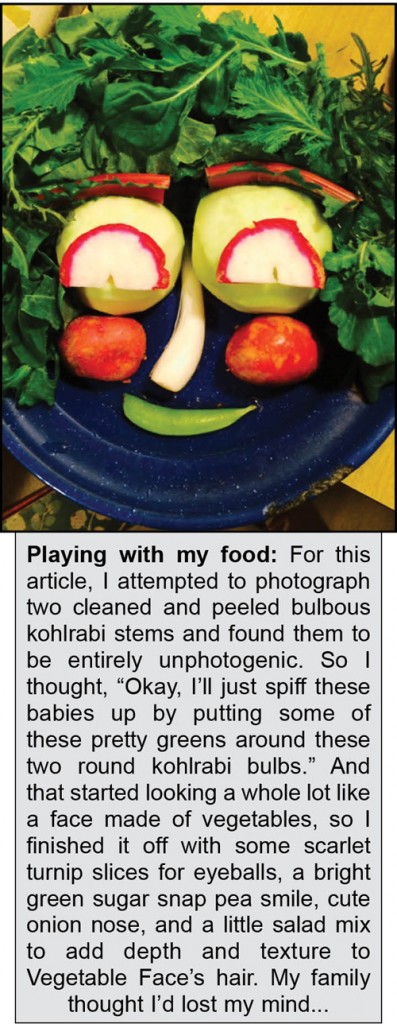 Baked: Kohlrabi makes good, less starchy baked home fries. Dice bulb, toss with chili powder, ground cumin, curry powder or paprika, non-GMO cornstarch, and olive oil and bake at 425 degrees for about 30 minutes or until crispy and brown.
Baked: Kohlrabi makes good, less starchy baked home fries. Dice bulb, toss with chili powder, ground cumin, curry powder or paprika, non-GMO cornstarch, and olive oil and bake at 425 degrees for about 30 minutes or until crispy and brown.
Fried: Cut into French fry-like sticks, deep fry and season to taste. Or make kohlrabi fritters by mixing the shredded bulb with egg and flour and frying in hot oil or butter.
Grilled: Slice the bulb into ¼ inch thick rounds. Season with salt, pepper, lemon juice, olive oil and fresh thyme then throw on the grill until tender.
Sauteed: Cook the greens and diced bulb like you would turnip roots and greens. Or try the greens and bulb sauteed with onions and finished with cream and nutmeg.
Pickled: Try a quick refrigerator pickle with ginger and honey or a fermented pickle with garlic and dill.
We all get into food ruts and there’s no better cure than trying something new. I cannot promise that our kohlrabis will re-organize your bookshelves or clean your windows, but they’ll certainly add interest and excitement to your local plate! Give one a try this week when you stop by Oxford City Market on Tuesday or Mid-Town Farmers’Market on Saturday.
Final note: Look for Yokna Bottoms kohlrabi on Snackbar’s upcoming menu! Plus find our collards at Local Flavor, our carrots at ravine, and our new potatoes at Oxford Canteen.


